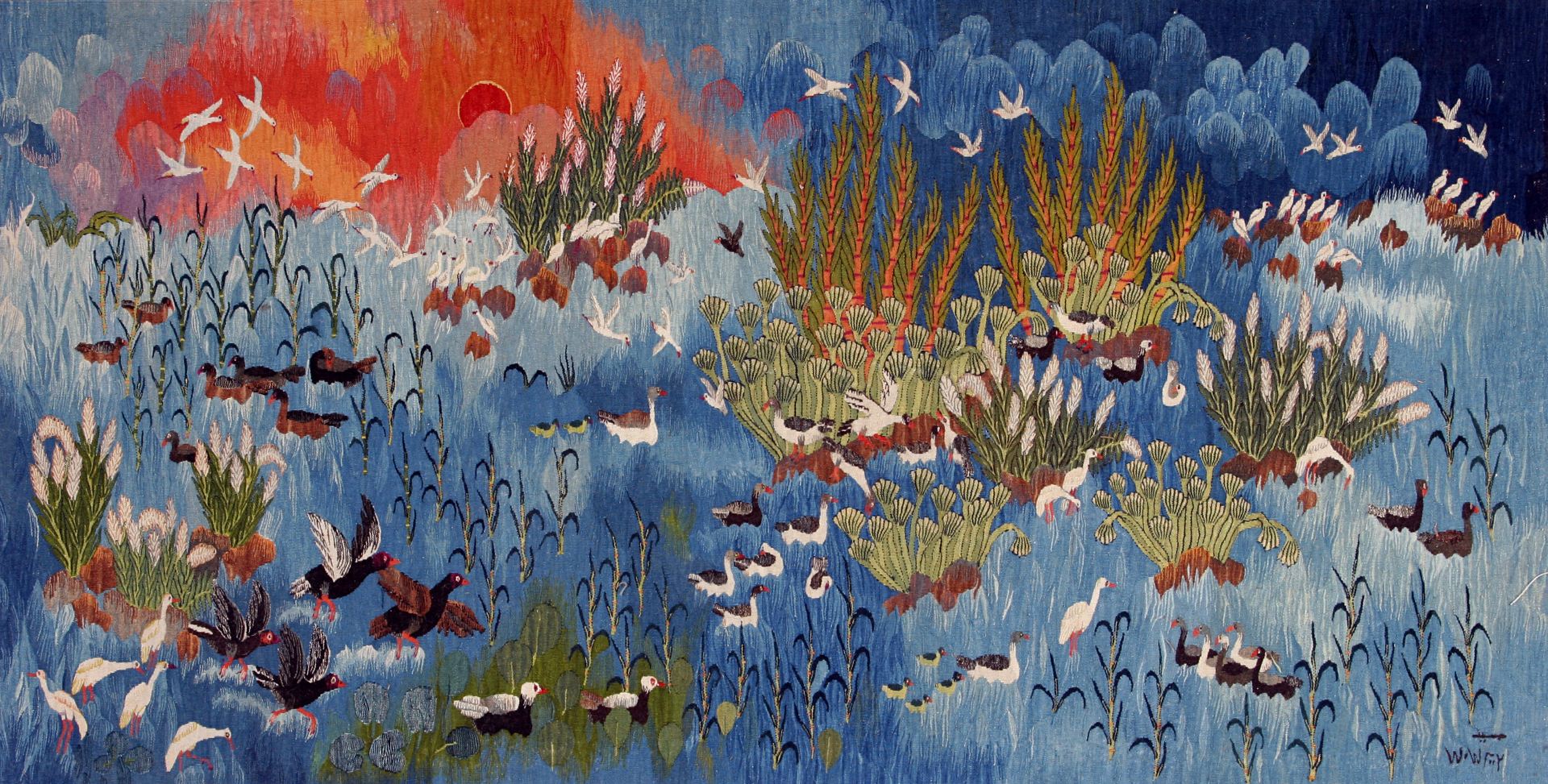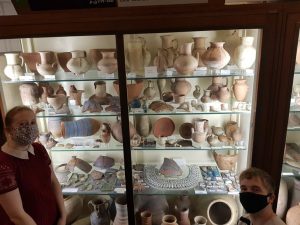From Egypt to Malet Place: the Wissa Wassef Tapestry in Context
By Anna E Garnett, on 13 July 2021
The Petrie Museum curatorial team is delighted to have hosted two UCL students, Naomi Allman and Max Chesnokov, as virtual curatorial volunteers during this academic year. Here, Naomi and Max describe the display project they worked on during their placement and reflect upon the experience and the skills they’ve gained during the process.
Introduction to the Project
Max and Naomi: Sayed Mahmoud’s beautiful tapestry, ‘Dahshur Lake’, was the focal point of our exhibition design project for the Petrie Museum. Woven in 2003 at the Ramses Wissa Wassef Art Centre in Saqqara, Egypt, our task was to design a new display around this important object, placing it firmly in its historical and geographical context.
A key part of this project was to link the tapestry with other objects from the Petrie Museum collection that reflect the ‘image world’ of the tapestry, particularly the vividly coloured faience objects in the collection from the royal city of Amarna in Middle Egypt. The result of this project is a comprehensive display package, ready for the Petrie Museum to use at a future date when the Wissa Wassef tapestry (currently in temporary storage) is redisplayed.
The two main themes we chose for this future display are ‘Heritage in the Landscape’ and ‘Manufacturing Art’, joined together by the vibrancy of colour in a modern tapestry and in fragments of ancient faience (a glazed artificial ceramic).
The first theme, ‘Heritage in the Landscape’, presents an image of a relatively unchanged landscape from Late Dynasty 18 in pharaoh Akhenaten’s capital of Amarna (around 1350BC) to now. The beautiful floral and faunal motifs, represented in both the tapestry and in the rich faience assemblage from Amarna in the Petrie Museum, represent some of the most important elements of ancient Egyptian art. Faience is known for its vibrant colour, and it is here that we have another link between past and present.
The second theme, ‘Manufacturing Art’, takes a closer look at the production processes behind these objects. Here we explored the development of colour itself, from its mineral origins through to pigment processing and application, as well as the continuity between ancient and modern production. Most striking is the first known representation of a loom (UC9547) and an ancient limestone palette (UC2484) placed alongside a modern plastic watercolour palette and a photograph of loom types still in use today.
The object we’ve chosen as a ‘spotlight object’ for the future display is a stunning faience beaded collar from Amarna, made up of 335 beads featuring vibrant floral motifs from grapes to petals and palm-leaves (UC1957). One bead in the collar even preserves the royal cartouche of Tutankhamun! This collar presents a unique link between Amarna faience and Sayed Mahmoud’s tapestry: a chance to bring together themes of colour, motif, and aspects of the Egyptian landscape both ancient and modern.
Reflecting on our Experience
Max: Working with the Petrie Museum’s collections has been incredible. Selecting only a handful of objects from its rich and representative tapestry (pardon the pun!) was a challenging yet rewarding experience as I got to know and understand these objects on a more intimate level. I enjoyed the process of selection based on not only the comparative links that they could evoke with Sayed Mahmoud’s art but also on their actual condition and viability for display. As a conservator-in-training I have a renewed desire to care for archaeological objects such as these as best I can in my future career so that they remain in place for future generations to learn from.
Naomi: As a child, I always loved seeing how the past is in many ways extraordinarily similar to the present, while still feeling like a whole different world. As an adult, it is my dream to work in museums and heritage, perhaps undertaking a similar role as this project. Working with the Petrie Museum’s collection has been an amazing experience, and one I will never forget. This museum is so unique, and I have loved working with it. I will take from this project a renewed love in Ancient Egypt (though my heart still belongs to Classical Archaeology!) and the joys the Petrie Museum holds.
 Close
Close





